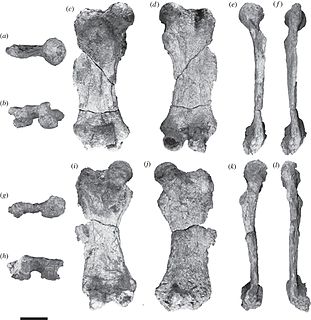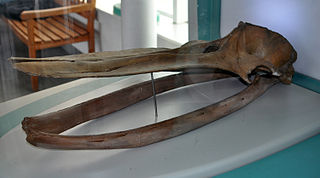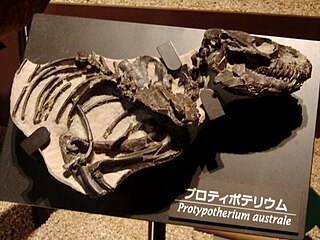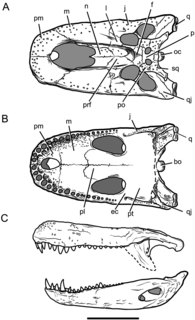 W
WAdinotherium is an extinct genus of Toxodontidae, large bodied hoofed ungulates which inhabited South America during the Middle to Late Miocene, from 17.5—6.8 Ma and existed for approximately 10.7 million years , Santacrucian to Huayquerian in the South American land mammal ages (SALMA). Fossils of Adinotherium have been found in the Santa Cruz and Ituzaingó Formations of Argentina and the Chucal and Río Frías Formations of Chile.
 W
WThe Angostura Formation is a Late Miocene geologic formation of the Borbón Basin in northwestern Ecuador.
 W
WCoquimbo Formation is a Miocene to Middle Pleistocene sedimentary formation located in Coquimbo Region in Norte Chico, Chile. The lowermost unit belongs to the lower Miocene, with the third-deepest unit dated at 11.9 ± 1.0 Ma. The uppermost unit of the formation is estimated at 1.2 Ma. In the area of Tongoy, the Coquimbo Formation was deposited in an ancient bay that was formed in a graben or half-graben, with a normal fault dipping east. Sea level changes during the Holocene have caused erosion to cut several marine terraces into the formation.
 W
WDiadiaphorus is an extinct genus of litoptern mammal from the Miocene of Argentina and Bolivia, South America.
 W
WEionaletherium is an extinct genus of ground sloth from the Late Miocene coasts of Venezuela containing one species: E. tanycnemius.
 W
WGryposuchus is an extinct genus of gavialoid crocodilian. It is the type genus of the subfamily Gryposuchinae. Fossils have been found from Argentina, Colombia, Venezuela, Brazil and the Peruvian Amazon. The genus existed during the Miocene epoch. One recently described species, G. croizati, grew to an estimated length of 10 metres (33 ft).
 W
WHapalops is an extinct genus of ground sloth from the Early to Late Miocene of Brazil, Bolivia, Colombia, and Argentina in South America.
 W
WHoffstetterius is an extinct genus of toxodontid notoungulate mammal, whose remains were discovered in the Middle to Late Miocene Mauri Formation in the La Paz Department in Bolivia. The only described species is the type Hoffstetterius imperator.
 W
WInteratherium is an extinct genus of Interatheriidae from the Early to Middle Miocene (Santacrucian-Mayoan). Fossils have been found in the Santa Cruz, Collón Curá and Sarmiento Formations in Argentina.
 W
WThe Letrero Formation is a Late Miocene geologic formation in south-central Ecuador. The formation comprises lacustrine sediments with strong fluvial clastic input and contains siltstones and fine-grained sandstones.
 W
WLycopsis is an extinct genus of South American metatherian, that lived during the Miocene in Argentina and Colombia.
 W
WMourasuchus is an extinct genus of giant, aberrant caiman from the Miocene of South America. Its skull has been described as duck like, being broad, flat and very elongate, closely resembling what is seen in Stomatosuchus, an unrelated crocodylian that may also have had a large gular sac similar to those of pelicans or baleen whales. Mourasuchus, is a strange nettosuchid with an unusually long, broad snout.
 W
WPelagornis is a widespread genus of prehistoric pseudotooth birds. These were probably rather close relatives of either pelicans and storks, or of waterfowl, and are here placed in the order Odontopterygiformes to account for this uncertainty.
 W
WPeltephilus, the horned armadillo, is an extinct genus of dog-sized, armadillo xenarthran mammals which first inhabited Argentina during the Oligocene epoch, and became extinct in the Miocene epoch. Notably, the scutes on its head were so developed that they formed horns. Aside from the horned gophers of North America, it is the only known fossorial horned mammal.
 W
WThe Pisco Formation is a geologic formation located in Peru, on the southern coastal desert of Ica and Arequipa. The approximately 640 metres (2,100 ft) thick formation was deposited in the Pisco Basin, spanning an age from the Middle Miocene up to the Early Pleistocene, roughly from 15 to 2 Ma. The tuffaceous sandstones, diatomaceous siltstones, conglomerates and dolomites were deposited in a lagoonal to near-shore environment, in bays similar to other Pacific South American formations as the Bahía Inglesa and Coquimbo Formations of Chile.
 W
WPiscobalaena is an extinct genus of cetaceans, which lived from the Middle to Late Miocene epochs in Peru and Florida. Its fossils have been found in the Pisco Formation of Peru and the Bone Valley Formation of Florida. At least some individuals of this diminutive whale were preyed on by the shark C. megalodon.
 W
WProtypotherium is an extinct genus of notoungulate mammals native to South America during the Miocene epoch. A number of closely related animals date back further, to the Paleocene. Fossils of Protypotherium have been found in the Deseadan Fray Bentos Formation of Uruguay, Muyu Huasi Formation of Bolivia, Cura-Mallín and Río Frías Formations of Chile, and Santa Cruz, Salicas, Ituzaingó, Cerro Bandera, Chichinales, Sarmiento and Collón Curá Formations of Argentina.
 W
WPurussaurus is an extinct genus of giant caiman that lived in South America during the Miocene epoch, from the Colhuehuapian to the Montehermosan in the SALMA classification. It is known from skull material found in the Brazilian and Peruvian Amazon, Colombian Villavieja Formation, Panamanian Culebra Formation and the Urumaco and Socorro Formations of northern Venezuela.
 W
WThylamys is a genus of opossums in the family Didelphidae. The premaxillae are rounded rather than pointed. The females lack a pouch. The females' nipples are arranged in two symmetrical rows on the abdomen. All species but T. macrurus store fat in their tails., although this is not necessarily true for all species in the genus. Fossils belonging to the genus date back to the Miocene, with the oldest specimens being found in the Cerro Azul Formation of Argentina and the Honda Group of Colombia. Genetic studies indicate that the genus may have originated around 14 million years ago.
 W
WToxodon is an extinct genus of South American mammals from the Late Miocene to early Holocene epochs. It is a member of Notoungulata, one of several now extinct orders of hoofed mammals indigenous to South America. It was among the largest and last members of its order, and was probably the most common large hoofed mammal in South America of its time.
 W
WTrigodon is an extinct genus of the family Toxodontidae, a large bodied notoungulate which inhabited South America during the Late Miocene to Early Pliocene, living from 11.61—4.0 Ma and existed for approximately 7.61 million years . The type species is T. gaudryi.
 W
WThe Tuira Formation is a geologic formation in Panama. It preserves bivalve, gastropod and sponge fossils dating back to the Tortonian period, from 11 to 9.5 Ma.
 W
WUrumaco is a town in Falcón State in Venezuela. It is of interest to paleontologists due to its rich fossil history. The arid climate of the region means that the fossils are not hidden by vegetation. The fossils were first made known to science by geologists who came across them while looking for oil, which is abundant in some parts of Venezuela. The paleontological wealth of Urumaco makes it the most fossil-rich zone of northern South America.
 W
WXenastrapotherium is an extinct genus of astrapothere, a type of hoofed herbivorous mammal, native to South America, which lived in the Middle to Late Miocene period, typically during the Laventan stage. It is a member of the family Astrapotheriidae in the subfamily Uruguaytheriinae, large astrapotheres, equipped with a trunk-like nose and protruding teeth, similar to the elephants, but their tusks were the canine teeth, not the incisors. Xenastrapotherium was a genus widely distributed in northern South America, in contrast to other species of astrapotheres which lived in the area of the Southern Cone of the continent. It differed from other astrapotheres by having two lower incisors on each side of the jaw and the tusks have a pronounced longitudinal curvature, although their general shape and size are probably very similar to Astrapotherium, whose weight would be 900 to 1,500 kilograms, comparable to the current black rhino.